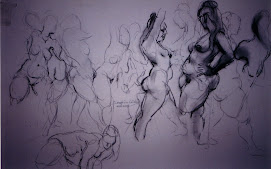


There is something to be said about positive thinking and visualisation of intended outcomes. It works! I will set out to prove to you that only does it work but it is also a good exercise in regulating your mood and emotional state of mind. Although it may not at first be apparent immediately. Take what I do as an art teacher for instance. I often visualise what my students could get out of the lesson that I am planning. Since the lesson is still in its planning stage, this is a good time to mentally get a grip on possible scenarios that may eventuate as a result of my aims and objectives. The thinking stage and working out how students would react to my lesson will have ironed out awkward wordings, embarassing faux pas and confusing ways of engaging kids through inappropriate examples.
To you it might all be speculations, all airy-fairy and unsubstantiated but there are basis for this thing that you might call merely, 'wishful thinking'. For example, a practical ceramics lesson can be potentially cringe-laden to young people if handled insensitively and inappropriately for the ages for whom the lesson is intended. There are also gender issues (for male & female teachers) that may arise as you do demonstrations that might involve bodily contact (on second thoughts try to limit this to a few occasions or none at all). It is a sad fact that teachers could no longer reassure students in distress, who might actually need it just because such actions might be misconstrued.
To get back to the Ceramics lesson example, if you are using the turn table, remember to wear proper and comfortable clothing (try to do this everyday, the more comfortable you are, the more you are also confident). Please don't make the mistake of displaying a decollatage (bosom) as bend over in controlling the clay. Although an experienced potter make it look effortless, to the beginner it is very difficult to 'center' your clay and keep it in one place. Make sure you do a question and answer session about every aspect of the activity before you let the kids have a go.
Prior to this demonstration, it would be advisable that you have briefed them in the basics and they know the terms, techniques, health & safety issues and problem-solving tricks when things go awry. Like all practical lessons, you would already have trained students into a routine that suits you. Please not to do the cleaning up yourself. Let it all be part of the lesson itself. How and why, I imagined you asked? This is where positive thinking and visualisation comes in. It applies here because it is a mistake to assume that kids will do as adults would in similar circumstances. When you imagine that they will be orderly in handling clay, they won't. If you assumed that they will go on a queue when in using coil-maker, they wont but more likely than not, they will quarrel on whose turn it is, or grab bits and start throwing then at each other.
When I say positive thinking, it doesn't mean picturing kids being orderly and then do nothing or not revising the plan if you can anticipate problems with the plan, and, just hope for the best because you either have done the lesson hundreds of times or is pressed for time. It doesn't work like that. Every lesson and every class is very different. Too many factors impinge on your cohort's behaviour before they even set foot in the classroom. Positive thinking is about anticipating events and precognitive visualisation. If you don't have a plan b, you are seriously making sure kids in your school will hate art. There should be at least several alternative sequences of events that you can take up. Use your plan as point of departure always keep it as your guideline. This is it is called a lesson plan and not a bible.
Positive thinking also does not mean expecting things to go as planned exactly. An art lesson almost never does according to plan. There is always something that is overlooked and unexpected. Being a good art teacher is making sure you can survive the hiccups and turning around an untoward incident into an advantage instead. Also the exciting part of being a practical teacher in art is recovering from embarassing and disastrous situations and learn from them so that they may never reoccur. This is how positive thinking and effective visualisation of scenarios in the planning stage helps you become a better art teacher.










































































No comments:
Post a Comment